![]()
![]()
![]()
Use LEFT and RIGHT arrow keys to navigate between flashcards;
Use UP and DOWN arrow keys to flip the card;
H to show hint;
A reads text to speech;
215 Cards in this Set
- Front
- Back
- 3rd side (hint)
|
Masonry |
Building with units of various natural/ manufactured products, such as stone, brick, or concrete block, usually with the use of mortar as a bonding agent |
|
|
|
field |
the expanse of a masonry wall between openings & corners, usually composed primarily of stretchers |
|
|
|
course |
a continuous, usually horizontal range of bricks, tiles, or shingles, as in a wall/roof |
|
|
|
range |
a continuous course of masonry ujits having the same height from end to end |
|
|
|
closer |
the last masonry unit laid in a course |
|
|
|
head joint |
the vertical joint between two masonry units, perpendicular to the face of a wall |
|
|
|
shoved joint |
a head joint formed by applying mortar to the end of a masonry unit & forcing it in position against the last masonry unit laid |
|
|
|
collar joint |
the vertical joint between two wythes of masonry |
|
|
|
wythe/ withe |
a continuous vertical section of a masonry wall one unit in thickness |
|
|
|
bed joint |
the horizontal joint between two masonry courses |
|
|
|
bed |
the underside of a brick or other masonry unit, or the layer of mortar in which a masonry unit is laid |
|
|
|
clip joint |
a bed joint made thicker than usual in order to level the course above |
|
|
|
corbel |
a brick or stone projecting from within a wall to support a weight |
|
|
|
head joint |
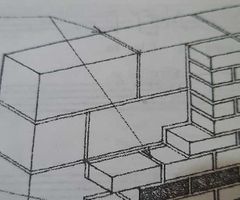
joint |
|
|
|
collar joint |

joint |
|
|
|
corbeling |
an overlapping arrangement of bricks or stones in which each course steps upward and outward from the vertical face of a wall |
|
|
|
wythe or withe |

|
|
|
|
corbeling |

|
|
|
|
point |
to fill and finish the surface of a masonry joint with mortar after the masonry has been laid, either to finish the joint or to repair a defective joint |
|
|
|
tuck pointing |
the process of raking out defective mortar from a masonry joint, filling with fresh mortar, and tooling the joint |
|
|
|
tuck and pat pointing |
pointing having an ornamental fillet of lime or putty projecting from the joint |
|
|
|
tuck and pat pointing |
pointing having an ornamental fillet of lime or putty projecting from the joint |
|
|
|
bastard pointing |
an imitation of tuck and pat pointing, having a fillet made from the mortar of the joint |
|
|
|
flat-joint pointing |
pointing having flush joints of common mortar |
|
|
|
flat-joint pointing |

POINTING |
|
|
|
concave joint |
curved, hollowed mortar joint formed by a rounded bar |
|
|
|
v-joint |
angular, hollowed mortar joint formed by a V- shaped jointer |
|
|
|
tooled joint |
weather- resistant mortar joint compressed and shaped with any tool other than a trowel |
|
|
|
troweled joint |
mortar joint finished by striking off excess mortar with a trowel |
|
|
|
raked joint |

mortar joint |
|
|
|
struck joint, a troweled joint |

mortar joint |
|
|
|
flush joint, a troweled joint |

mortar joint |
|
|
|
weathered joint, troweled joint |

mortar joint |
|
|
|
V-joint, a tooled joint |

a mortar joint |
|
|
|
concave joint, a tooled joint |

mortar joint |
|
|
|
tuck and pat pointing |
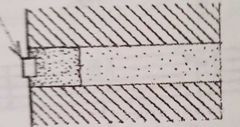
POINTING |
|
|
|
tuck pointing |
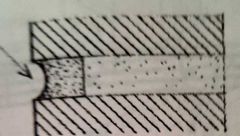
POINTING |
|
|
|
solid masonry |
a wall constructed of brick or other solid masonry units laid contiguously with all joints solidly filled with mortar and adjacent wythes bonded by masonry headers or metal ties. |
|
|
|
cavity wall |
a masonry wall having a facing and backing completely separated except for metal ties and enclosing an inner space serving to prevent penetration by water |
|
|
|
facing |
an ornamental or protective layer, such as the outer wythe of a masonry wall |

|
|
|
backing |
something that forms the back or provides support, strength, or protection from the back, such as the inner wythe or wythes of a masonry wall |
|
|
|
weep hole |
a small opening in a cavity wall, retaining wall, or other construction for draining off accumulated moisture, as from condensation or leakage |
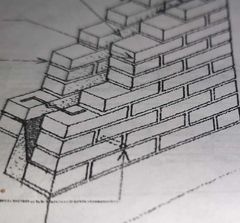
|
|
|
faced wall |
a wall having a masonry facing bonded to a backing so as to exert a common action under load |

|
|
|
veneered wall |
a wall having a nonstructural facing attached but not bonded to a supporting structure |

|
|
|
veneer |
a nonstructural facing of brick, stone, concrete, or tile attached to a backing for the purpose of ornamentation, protection, or insulation |

|
|
|
anchored veneer |
a veneer supported by and secured to a backing by means of mechanical fasteners |
|
|
|
economy wall |
A brick wall 4 in. (102mm) thick, plastered and strengthened at intervals with 8-in. (203 mm) pilasters to support roof trusses |
|
|
|
composite wall |
a masonry wall having at least one wythe dissimilar to the other wythe or wythes with respect to type or grade of masonry unit or mortar |
|
|
|
composite wall |
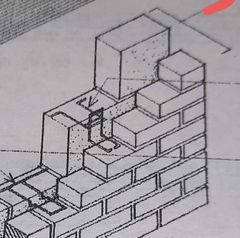
(the one with red marks) |
|
|
|
adjustable tie |
a metal tie consisting of two interlocking parts that enable it to adapt to bed joints at different elevations |
|
|
|
adjustable tie |

|
|
|
|
tie |
Any of various corrosive-resistant metal devices for holding two parts of construction together, such as wythes of a masonry wall |

|
|
|
back plaster |
To parge a part of a wall that is not seen, such as behind the outer wythe of a cavity wall in order to exclude air & moisture from the interior of the wall |

|
|
|
panel wall |
a non-load-bearing exterior masonry wall wholly supported at each story |

|
|
|
Lewis |
a device for lifting a dressed stone or precast concrete panel, consisting of a number of pieces fitting together to fill a dovetailed recess cut into the stone or panel |

|
|
|
soft joint |
a compressible joint directly below a supporting shelf or relieving angle, allowing for the expansion & contraction of a panel wall and preventing the weight of higher courses from being transmitted to the masonry below |

|
|
|
grouted masonry |
a wall constructed of brick or concrete brick units with all interior joints being filled with grout as the work progresses |
|
|
|
high- lift grouting |
a technique for grouting a masonry wall constructed a story at a time in lifts not exceeding 6 feet (1.8m) |
|
|
|
low-lift grouting |
a technique for grouting a masonry wall in lifts not exceeding six times the width of the grout space or a maximum of 8 inches (203 mm) at the wall is built |
|
|

grout pour |
the total height of masonry wall to be filled with grout before the erection of additional masonry, consisting of one or more grout lifts |
|
|
|
grout lift |
an increment of grout height within a total grout pour |
|
|
|
cleanout |
any series of temporary openings at the bottom of a masonry wall large enough to permit the removal of debris or obstructions from a cavity or cell prior to grouting |
|
|
|
grout |
a fluid cement mortar that will flow easily without segregation of the ingredients, used to fill narrow cavities in masonry and consolidate the adjoining materials into a solid mass |
|
|
|
bond |
the adhesion between mortar or grout and masonry units or steel reinforcement being cemented |
|
|
|
reinforced grouted masonry |
a masonry wall constructed with horizontal and vertical steel reinforcement fully embedded in grout for increased resistance to buckling and lateral wind and seismic loads |

|
|
|
hollow unit masonry |
a wall constructed of hollow masonry units laid and set with mortar, with adjacent wythes bonded by masonry headers or metal ties |
|
|
|
reinforced hollow-unit masonry |
hollow unit masonry having certain cells continuously filled with concrete or grout, in which reinforcing steel is embedded for increased resistance to buckling and lateral wind and seismic loads |
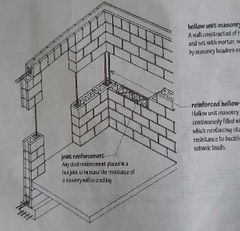
|
|
|
joint reinforcement |
any steel reinforcement placed in a bed joint to increase the resistance of a masonry wall to cracking |
|
|
|
mortar |
a plastic mixture of lime or cement, or a combination of both, with sand & water, used as a bonding agent in masonry construction |
|
|
|
cement mortar |
a mortar made by mixing portland cement, sand, and water |
|
|
|
cement-lime mortar |
a cement mortar to which lime is added to increase its plasticity and water-retentivity |
|
|
|
masonry cement |
a propriety mix of portland cement & other ingredients, such as hydrated lime, plasticizers, air-entraining agents, and gypsum, requiring only the addition of sand and water to make cement mortar. |
|
|
|
epoxy mortar |
a mortar consisting of epoxy resin, a catalyst, & fine aggregate |
|
|
|
nonstaining mortar |
a mortar having a low free-alkali content to minimize efflorescence or the staining of adjacent masonry by the migration of soluble materials |
|
|
|
Lime mortar |
a mixture of lime, sand, water that is rarely used because of its slow rate of hardening and low compressive strength |
|
|
|
Lime (a.k.a. calcium oxide, calx, caustic lime, quicklime) |
a white or grayish white, caustic, odorless solid obtained by heating forms of calcium carbonate, such as shells or limestone, at a high temperature |
|
|
|
hydrated lime (a.k.a. calcium hydroxide, slaked lime) |
a soft, crystalline powder obtained by the action of water on lime and used in making mortar, plaster, and cement |
|
|
|
green |
of or pertaining to concrete or mortar that is firmly set but not completely hardened |
|
|
|
fat mix (also, rich mix) |
a concrete or mortar mix that is easy to work or spread because of a relatively high cement or lime content |
|
|
|
Lean mix |
a concrete or mortar mix that is difficult to work or spread because of a shortness of cement or lime |
|
|
|
plasticizer |
an admixture for making a concrete or mortar mix workable with little water |
|
|
|
Type M mortar |
a high-strength mortar recommended for use in reinforced masonry below grade or in contact with the earth, such as foundation and retaining walls subject to frost action or to high lateral or compressive loads |
|
|
|
Type S mortar |
A medium-high strength mortar recommended for use in masonry where bond and lateral strength are more important than compressive strength |
|
|
|
Type N mortar |
A medium-strength mortar recommended for general use in exposed masonry above grade where high compressive and lateral strength are not required |
|
|
|
Type O mortar |
a low-strength mortar suitable for use in interior non-load bearing walls and partitions |
|
|
|
Type K mortar |
A very-low-strength mortar suitable only for use in interior non-loadbearing walls where permitted by the building code |
|
|
|
rubble |
rough fragments of broken stone or the masonry built of such stones |
|
|
|
gallet/ garret |
To embed small stone chips in the mortar joints of rough masonry to wedge larger stones in position or add detail to the appearance |

|
|
|
random rubble |

type of wall |
|
|
|
random rubble |
a rubble wall having a discontinuous but approximately level beds or courses |
|
|
|
coursed rubble |
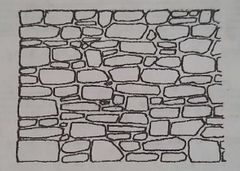
type of wall |
|
|
|
coursed rubble |
a rubble wall having approximately level beds & brought at intervals to continuous level courses |
|
|
|
squared rubble |
a rubble wall built of squared stones of varying sizes & coursed at every third or fourth stone |
|
|
|
squared rubble |

a type of wall |
|
|
|
cyclopean |
formed with large, irregular blocks of stones fitted closely together without the use of mortar |
|
|
|
cyclopean |

|
|
|
|
ashlar |
a squared building stone finely dressed on all faces adjacent to those of other stones so as to permit very thin mortar joints |

|
|
|
random ashlar |

masonry built |
|
|
|
coursed ashlar |
ashlar masonry built of stones having the same height within each course, but each course varying in height |
|
|
|
coursed ashlar |

masonry built |
|
|
|
broken rangework |
ashlar masonry laid in horizontal courses of varying heights, any one of which may be broken at intervals into two or more courses |
|
|
|
broken rangework |

|
|
|
|
quoin |
an exterior angle of a masonry wall, or one of the stones or bricks forming such an angle, usually differentiated from adjoining surfaces by material, texture, color, size, or projection |

|
|
|
quoin |

|
|
|
|
perpend or through stone |

|
|
|
|
perpend or through stone |
a large stone passing through the entire thickness of a wall and exposed on both faces |
|
|
|
bondstone/ binder |
a stone for bonding facing masonry to a masonry backing |
|
|
|
bondstone/ binder |

|
|
|
|
long-and-short work |
an arrangement of rectangular quoins/ jambstones set alternately horizontally and vertically |
|
|
|
long-and-short work |

|
|
|
|
in-and-out bond |
A masonry bond having headers & stretchers alternating vertically |
|
|
|
in-and-out bond |

|
|
|
|
cramp iron |
an iron bar or rod with bent ends for holding together stone masonry units |

|
|
|
rustication |
ashlar masonry having the visible faces of the dressed stones raised or otherwise contrasted with the horizontal and usually the vertical joints, which may be rabetted, chamfered, or beveled |
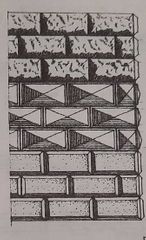
|
|
|
rustic joint |
A mortar joint between stones recessed from the adjacent faces between sunken drafts or bevels |
|
|
|
rustic |
having rough, irregular surfaces & sunken or beveled joints |
|
|
|
interlocking joint |
a joint in ashlar masonry made by fitting a projection on one stone into a routed groove on the next stone |

|
|
|
capstone |
A finishing stone of a structure, such as a copestone |
|
|
|
kneeler (also skew) |
any of the stones having a sloping top for supporting or forming a gable coping |
|
|
|
skew corbel |
a stone overhanging at the foot of a gable coping, often serving as a stop for eave gutters or wall cornices |
|
|
|
copestone |
a stone forming a coping |
|
|
|
dripstone |
a stone molding used as a drip, as on a cornice over a window or doorway |
|
|
|
string course (a.k.a. belt course) |
A horizontal course of brick or stone flush with or projecting beyond the face of a building, often molded to mark a division in the wall |
|
|
|
string course (a.k.a. belt course) |
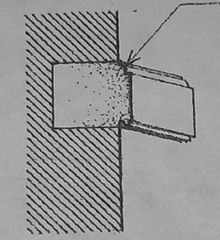
|
|
|
|
copestone |

|
|
|
|
dripstone |

a stone molding |
|
|
|
cordon |
a string course, esp. one having little or no projection |
|
|
|
table |
a course/band, esp. of masonry, having a distinctive form/ position |
|
|
|
water table |
a projecting string course, molding, or ledge placed so as to divert rainwater from a building |
|
|
|
water table |
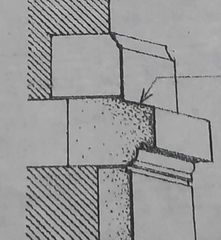
a projecting string course/molding/ledge |
|
|
|
scarcement |
a footing/ledge formed by a setback in the face of a wall |
|
|
|
plinth/ plinth course |
a continuous, usually projecting course of stones forming the base or foundation of a wall |
|
|
|
plinth/ plinth course |

|
|
|
|
corbie gable |
a gable having corbiesteps |
|
|
|
corbiestep/ crowstep |
a series of steplike projections that terminate a masonry gable above the surface of the roof |
|
|
|
corbiestep/ crowstep |

|
|
|
|
saddle joint |
a vertical joint raised above the level of the washes on a stone sill or coping to prevent the penetration of rainwater |
|
|
|
saddle joint |
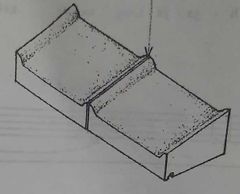
|
|
|
|
fractable |

|
|
|
|
fractable |
a coping on a gable wall concealing the slopes of the roof, esp. one having an ornamental silhouette |
|
|
|
boss |
a stone roughly formed and set in place for later carving |

|
|
|
tail in |
to fasten a beam or stone by one end |
|
|
|
tailing |
the part of a stone/brick projecting from a wall |

|
|
|
label |
a molding/dripstone over a door or window, esp. one that extends horizontally across the top of the opening and vertically downward for a short distance at the sides |
|
|
|
label |
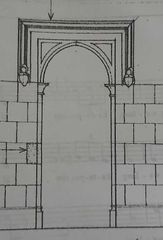
|
|
|
|
jambstone |
a stone, or one of the stones, forming the jamb of a door/window opening |
|
|
|
embrasure |
a splayed enlargement of a door/ window opening toward the inner face of a wall |

|
|
|
solid masonry unit |
a masonry unit having a net cross-sectional area in any plane parallel to the bearing surface that is 75% or more of the gross cross-sectional area measured in the same plane |
|
|
|
hollow masonry unit |
a masonry unit having a net cross- sectional area in any plane parallel to the bearing surface less than 75% of the gross cross-sectional area measured in the same place |
|
|
|
gross cross-sectional area |
the total cross- sectional area of a hollow masonry unit perpendicular to the direction of loading, including cellular and reentrant spaces, except when these spaces are to be occupied by portions of adjacent masonry |
|
|
|
net cross- sectional area |
the gross cross-sectional area of a hollow masonry unit minus the area of ungrouted cores of cellular spaces |
|
|
|
equivalent thickness |
the thickness that would be obtained if the amount of concrete contained in a hollow masonry unit were recast without any cellular spaces, used esp. to determine the fire resistance of a wall constructed with such units |
|
|
|
absorption |
the weight of water absorbed by a concrete masonry unit when immersed in water, expressed in pounds of water per cubic foot of concrete |
|
|
|
Grade N |
a grade of load- bearing concrete masonry unit suitable for general use, as in exterior walls above and below grade |
|
|
|
Grade S |
a grade of load-bearing concrete masonry unit limited to use above grade, in exterior walls with weather- protective coatings, or in walls not exposed to the weather |
|
|
|
Type I |
a concrete masonry unit manufactured to a specified limit of moisture content in order to minimize the drying shrinkage that can cause cracking |
|
|
|
Type II |
a concrete masonry unit not manufactured to a specified limit moisture content |
|
|
|
lightweight block |
A concrete masonry unit made with lightweight aggregate, such as cinder or expanded slag, and weighing less than 125pcf (2000 kg/m^3) |
|
|
|
normal- weight block |
a concrete masonry unit made with sand,gravel, or other dense aggregate and weighing more than 125 pcf (2000 kg/m^3) |
|
|
|
surface bonding |
The bonding of a concrete masonry wall by stacking the units without mortar and troweling on a stucco-like compound of hydraulic cement and glass fiber |
|
|
|
concrete masonry unit |
a precast masonry unit of portland cement, fine aggregate, and water, molded into various shapes |
|
|
|
concrete block |
a hollow/ solid concrete masonry unit, often incorrectly referred to as cement block |
|
|
|
stretcher block |
A concrete masonry unit having nominal dimensions of 8 x8 x16in |
|
|
|
stretcher block |
A concrete masonry unit having nominal dimensions of 203 x 203 x 406 mm |
|
|
|
partition block |
a concrete masonry unit used in constructing non-load bearing walls, usually having a nominal thickness of 4 or 6 in (102mm or 152mm) |
|
|
|
partition block |

|
nominal thickness is usually 4 or 6 in (102 or 152mm) |
|
|
bullnose block |
a concrete masonry unit having one or more rounded exterior corners |
|
|
|
bullnose block |

|
|
|
|
corner block |
a concrete masonry unit having a solid end face and used in constructing the end or corner of a wall |
|
|
|
1. corner block 2. return-corner block |

|
|
|
|
return-corner block |
a concrete masonry unit used at the corners of 6-,10-, 12-in (152-,254-,& 305-mm) walls to maintain horizontal coursing with the appearance of full-and half- length units |
|
|
|
double-corner block |
a concrete masonry unit having solid faces at both ends and used in constructing a masonry pier |
|
|
|
double-corner block |

|
|
|
|
pilaster block |
any various concrete masonry units used in constructing a plain or reinforces masonry pilaster |
|
|
|
pilaster block |

|
|
|
|
coping block |
a solid concrete masonry unit used in constructing the top or finishing course of a masonry wall |
|
|
|
coping block |
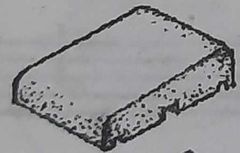
|
|
|
|
sash block/ jamb block |
a concrete masonry unit having an end slot or rabbet to receive the jamb of a door or window frame |
|
|
|
sash block/ jamb block |

|
|
|
|
sill block |
a solid concrete masonry unit having a wash to shed rainwater from a sill |
|
|
|
1. sill block 2. wash/ weathering |
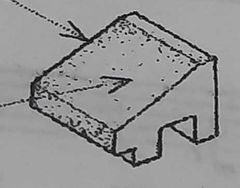
|
|
|
|
wash/ weathering |
an upper surface inclined to shed rainwater from a building |
|
|
|
cap block/ solid- top block |
a concrete masonry unit having a solid top for use as a bearing surface in the finishing course of a foundation wall |
|
|
|
cap block/ solid- top block |

|
|
|
|
control- joint block |
any of various concrete masonry units used in constructing a vertical control joint |
|
|
|
control- joint block |

|
|
|
|
bond-beam block |
a concrete masonry unit used in constructing a bond beam, having a depressed section in which reinforcing steel can be placed for embedment in grout |
|
|
|
bond-beam block |
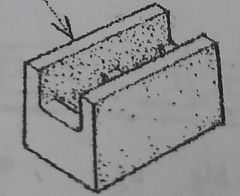
|
|
|
|
bond beam |
a masonry course grouted and reinforced to serve as a beam, a horizontal tie, or bearing course for structural members |
|
|
|
sand- lime brick |
a hard, light- colored brick made by molding a mixture of damp sand and slaked lime under high pressure and curing in a steam oven |
|
|
|
concrete brick |
a solid rectangular concrete masonry unit, usually not larger than 4x4x12in (102mmx102x305mm) |

|
|
|
screen block |

|
|
|
|
screen block |
a concrete masonry unit used esp. in tropical architecture, having a decorative pattern of tranverse openings for admitting air and excluding sunlight |
|
|
|
shadow block |
any various concrete masonry units having a face shell with a pattern of beveled recesses |
|
|
|
shadow block |
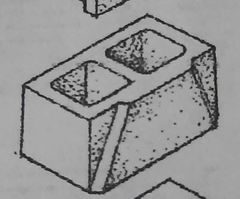
|
|
|
|
scored block |
any various concrete masonry units having one or more vertical grooves that stimulate raked joints |
|
|
|
scored block |

|
|
|
|
faced block |
a concrete masonry unit having a special ceramic, glazed, or polished face |
|
|
|
faced block |

|
|
|
|
split-face block |
a concrete masonry unit, split lengthwise by a machine after curing to produce a rough, fractured face texture |
|
|
|
split-face block |

|
|
|
|
slump block |
a concrete masonry unit having an irregular face and surface texture caused by the settlement of a wet mix during curing |
|
|
|
slump block |
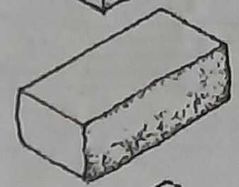
|
|
|
|
sound-absorbing masonry unit |
a concrete masonry unit having a solid top and a slotted face shell, and sometimes a fibrous filler, for increased sound absorption |
|
|
|
sound-absorbing masonry unit |

|
|
|
|
header block |
a concrete masonry unit having a portion of one face shell removed to receive headers in a bonded masonry wall |
|
|
|
header block |
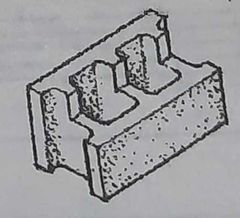
|
|
|
|
Lintel block |
a concrete masonry unit used in constructing a lintel or bond beam, having a U- shaped section in which reinforcing steel can be placed for embedment in grout |
|
|
|
Lintel block |

|
|
|
|
open-end block |
a concrete masonry unit having one end open in which vertical steel reinforcement can be placed for embedment in grout |
|
|
|
open-end block |

|
|
|
|
face shell |
one of the two sidewalls of a hollow concrete masonry unit |
|
|
|
web |
one of the cross walls connecting the face shells of a hollow masonry unit |
|
|
|
core/ cell |
the molded open space in a concrete masonry unit |
|
|
|
1. stretcher block 2. core/ cell 3. face shell 4. web |

|
|

